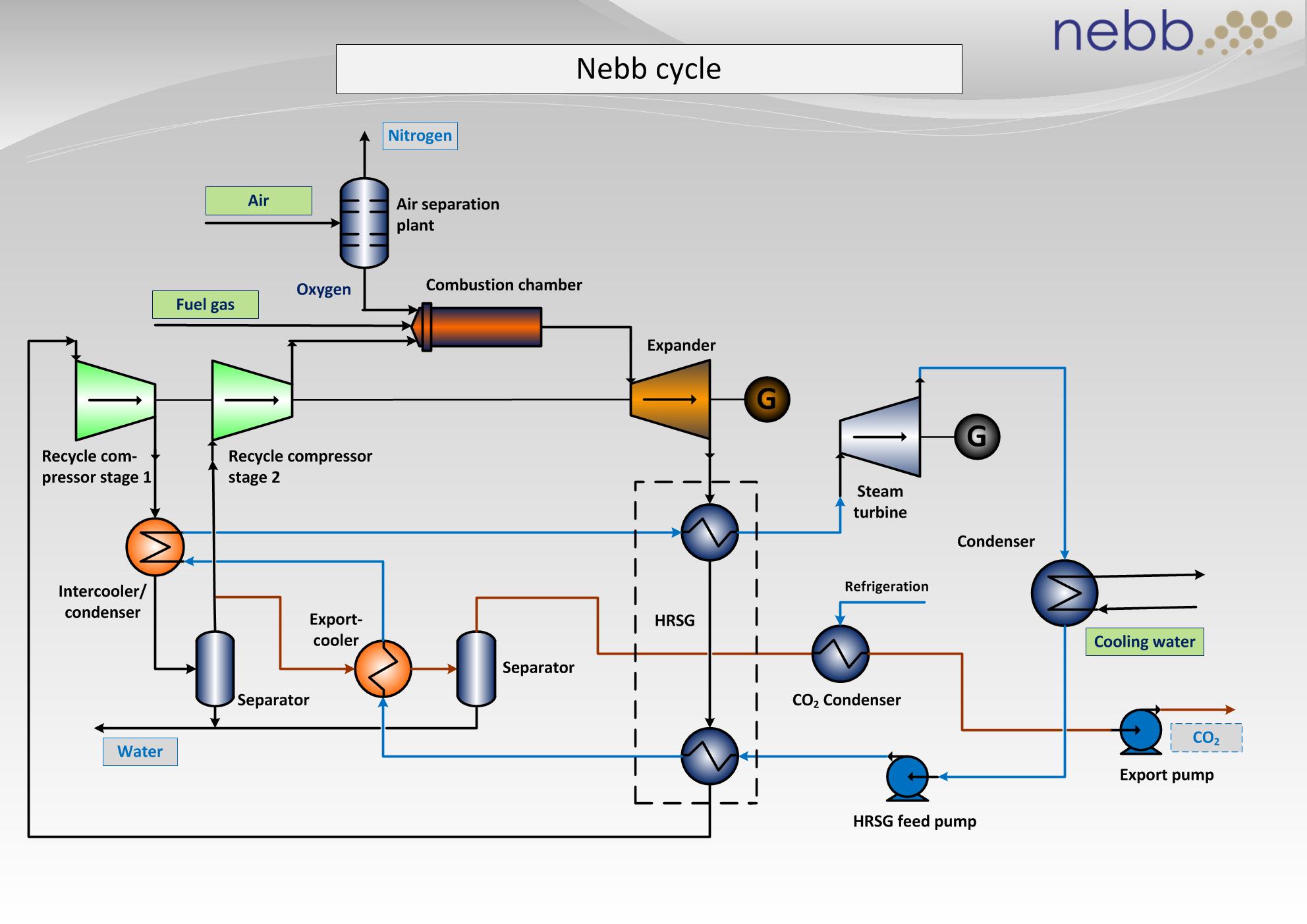
Nebb has developed an oxyfuel power process that demonstrates an optimal separation of CO2 and H2O.
The principle of our process solution is shown in the figure below. The design is of a simple zero emission power plant with oxygen combustion under stoichiometric conditions. The process consists of a gas turbine in combination with a steam turbine that recovers energy in the expanded exhaust gas.
The process is similar to a conventional combined cycle power plant. The biggest difference is the working medium in the process, which is generated by fuel combustion in almost pure oxygen. The energy in the expanded warm exhaust gas produces steam in a Heat Recovery Steam Generator (HRSG) that is principally similar to a conventional combined cycle power plant.
The cooled exhaust gas, mainly CO2 and water vapour, is recycled back to a compressor. Between the compressor stages, an intercooler is installed. In the intercooler, the gas is cooled and some of the water is condensed out. After the compressor, some of the pressurized CO2/H2O-mixture is led to a Heat Recovery Condenser Separator (HRCS) unit, where the CO2 and H2O are completely separated by cooling and vapour condensation. The rejected heat from the cooling and condensation processes is utilised in the bottoming steam cycle. After HRCS the CO2 gas is further compressed to a delivery pressure.

The process captures the CO2 produced. This enables redistribution and sale of the captured CO2 for industrial purposes, or deposit in suitable geological structures.
Another advantage of the oxyfuel process is that there are almost no emissions of nitrogen oxides, as nitrogen is removed prior to the combustion.
Unique features of the process:
The partial condensation of the working fluid in the intercooler makes it possible to adjust the composition of the working fluid to best suit the turbine and the overall process efficiency. High-efficiency gas turbines are sensitive to gas composition, and they are very expensive to develop. It is thus advantageous if it is possible to use the same turbine for various fuel types. The adjustment of the composition of the working fluid through the partial condensation in the intercooler allows for this possibility.
The pressurized separation makes it easier to utilise rejected heat from vapour condensation. The condensation temperature is dependent on the condensation pressure; a higher separation pressure gives a higher separation temperature.
A higher temperature level represents larger exergy, a theoretical measurement that indicates the potential to produce work from a given energy source. This means that the higher the condensation pressure or temperature the greater the potential to transform rejected heat from condensation into high-quality energy as work in the steam cycle.
By extracting the export gas stream after the recompression in the turbine compressor, the number of compressors required to compress the CO2 to the export pressure is reduced.
The main market for this process is coal-based power production, where gasified coal is the fuel for the gas turbine.
Nebb provide total solutions for automation, electrical and information systems to a number of industries world-wide, including process industry, food & pharma, marine, energy, subsea, and PMC.
Our core competence lies within automation, electrical, instrumentation, SCADA, software, and digitalisation.
[fa icon="phone"] +47 66908300
[fa icon="envelope"] sales@nebb.com
[fa icon="envelope"] general@nebb.com
[fa icon="home"] Solbråveien 43, Asker Norway